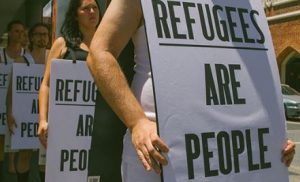How to have conversations about refugees
Issues around migrants and refugees can be divisive and the negative rhetoric can ramp up as elections approach.
Often, groups or parties weaponise these issues to achieve their political goals and it can be difficult to counter the emotive, negative and often false narratives that emerge.
Refugee advocate and community development expert Maria Tsopanis says a reasoned approach based on fact is always the best way to engage in a conversation about refugees.
“Getting sucked into an emotive argument about refugees or migration with someone who may be poorly informed risks seeing the conversation descend into dead-end argument,” Ms Tsopanis said.
“It’s best to try to counter assertions calmly with facts and to try to get the person to think about what they are saying and where they have gotten their views from.
“But while it is important to stay rational and reasonable, we should not give up and fail to confront views that maybe misguided or even racist.
“If we don’t, we risk letting these narratives spread and become more entrenched,” Ms Tsopanis said.
Some suggestions and scenarios
If someone says: “We can’t let everyone in just because they want to come here.”
Maybe try responding: “Actually, 75 per cent of refugees seek safety close to their home countries. Those who come here do so because they have no other choice; they are fleeing persecution and life-threatening situations. They don’t migrate because they want to; they migrate because they have no other choice.”
If someone says: “What if they just say they’re refugees, but really they are just coming over to cause trouble?”
Try responding: “Refugees are vetted more intensely than any other group before they are allowed to enter. It can take years for this vetting process to be complete. The asylum process can similarly take years to conclude.”
If someone says: “The number of people coming is too high—someone on TV called it an ‘invasion.'”
Try responding: “Please don’t dehumanise people with language like ‘invasion’. Refugees are more than just numbers. They are people with dreams, hopes and ambitions who are fleeing impossible circumstances.”
If someone says: “Well who pays for all this? Shouldn’t we take care of our own?”
Try responding: “Refugees start businesses, pay taxes and contribute to their communities and local economies. The vast majority quickly find jobs and become productive members of their new communities.”
If someone says: “People coming to Australia as asylum seekers are jumping the queue.”
Try responding: “Some people are forced to flee their homes and countries because of persecution or conflict. Imagine if you and your children were faced with being imprisoned, enslaved or worse. What would you do?”
Some interesting facts about refugees
Who hosts refugees?
Wealthy countries host just 24 per cent of refugees. The remaining 76 per cent are hosted by poor, low and middle-income countries.
Turkey is the single biggest host country for refugees. Most refugees living in Turkey come from Syria, where an ongoing conflict has displaced families since 2011.
Most refugees live in neighbouring countries
 Media coverage of refugees often focuses on those making long journeys to reach host countries, but most refugees live in places immediately bordering their home country.
Media coverage of refugees often focuses on those making long journeys to reach host countries, but most refugees live in places immediately bordering their home country.
Jordan, for example, hosts the second-highest number of refugees per capita in the world, hosting more than two million registered Palestinian refugees and over 760,000 individuals of other nationalities including people from Syria, Iraq, Yemen and Somalia.
More than half of refugees come from just three countries
Fifty-two per cent of all refugees in the world were displaced from just three countries by the end of 2022: Syria, Afghanistan and Ukraine.
The Refugee Convention is an international agreement to protect refugees
Almost 150 countries have agreed to provide refugees with protections under the 1951 Refugee Convention. This agreement was introduced following WW II when many people fled persecution and conflict in Europe.
Seeking asylum is a universal human right
Refugees’ right to seek asylum in another country is included in the Universal Declaration of Human Rights alongside the right to a fair trial and freedoms of religion and expression.
What is a refugee?
A refugee is someone who has been forced to leave their country in order to escape war or persecution. They are unable to return home until conditions are safe for them again.
What is an asylum seeker?
Asylum seekers are people who are in the process of claiming protection in another country. Once an asylum claim is recognised by a host country then they can live in their host country as a refugee.
The right to seek asylum is recognized as a universal human right. Article 14 of the Universal Declaration of Human Rights states that “Everyone has the right to seek and to enjoy in other countries asylum from persecution.”
What about Australia?
Australia takes in about 20,000 refugees for permanent resettlement each year, among the highest per capita intake in the world. Since WWII Australia has taken in a million refugees, who have successfully settled and contributed to Australian society.
Some useful websites












